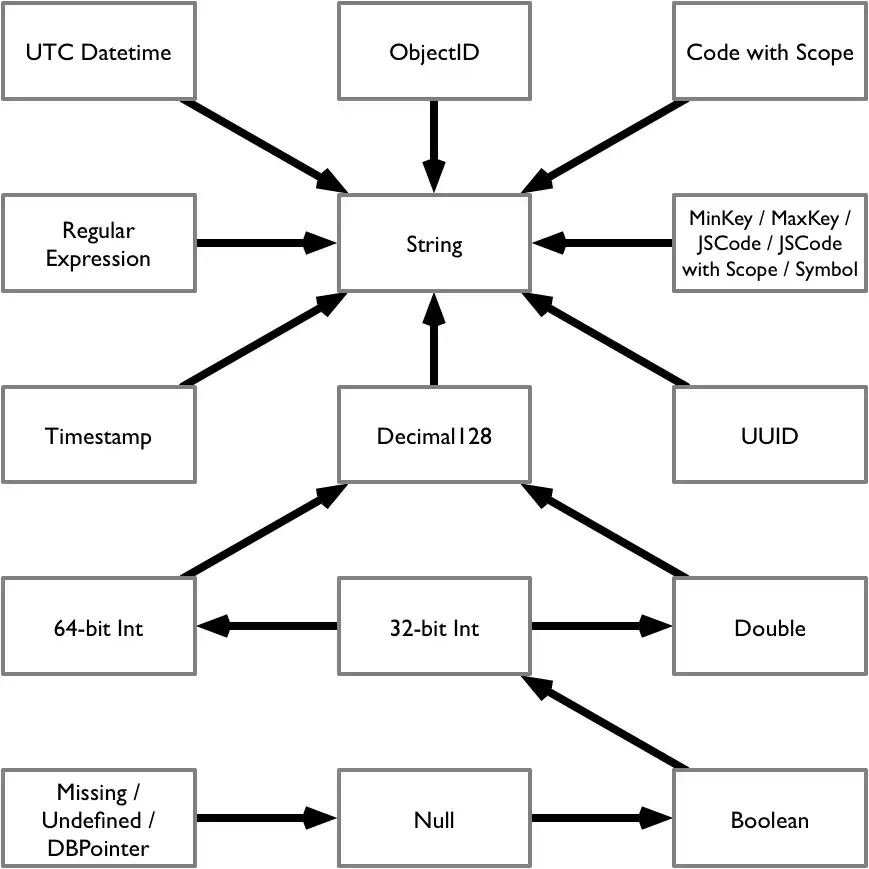Changed in version 2.6.
The flexible schema model of MongoDB allows a given field to contain data of multiple types, while relational databases restrict columns to a single data type. The BI Connector samples data from MongoDB to generate a relational schema model, but type conversion conflicts may occur when the BI Connector samples different data types from a field in MongoDB documents.
There are two main categories of type conversion conflicts that may occur in the presence of multiple data types: conflicts between scalar types and conflicts involving composite types like documents and arrays.
Note
The BI Connector only uses the sampled subset of your data to detect type conflicts during schema generation. If your data set contains type conflicts on a field and the conflicting types were not both present in the sample, the generated schema will not be prepared to resolve these conflicts and may result in increased query latency.
For more information on sampling configuration, such as setting
the --samplesize and
--schemaRefreshIntervalSecs,
see Schema Options.
Scalar-Scalar Conflicts
When a scalar-scalar confict occurs, the BI Connector uses the following lattice to determine the least upper bound of the two different data types:

Example
If a given field contains int, double, and string types,
the least upper bound is string.
When a scalar-scalar conflict occurs, the BI Connector inserts a row into
the information_schema.COLUMNS table and lists the different sampled
types in the COLUMN_COMMENT column.
Composite Conflicts
Composite conflicts are type conversion conflicts involving a document or an array. The following sections describe how the BI Connector resolves both types of composite conflicts.
Document Conflicts
When a conflict occurs involving a document, the BI Connector
displays the fields of the document type as separate columns using
dot notation. For example, the conflict collection contains the
following documents:
{ _id: 0, a: "foo" } // "a" is scalar (string) { _id: 1, a: { a: "bar", b: "baz" } } // "a" is composite (document)
The BI Connector detects a scalar-composite conflict and generates the following relational schema:
Table: conflict
_id | a | a.a | a.b |
|---|---|---|---|
0 | "foo" |
|
|
1 |
| "bar" | "baz" |
When a conflict occurs involving a document, the BI Connector inserts a
row into the information_schema.COLUMNS table and lists the
different sampled types in the COLUMN_COMMENT column.
Array Conflicts
When a conflict occurs involving an array, the BI Connector creates a new
table for the conflict field with a column for the foreign key, array
index, and value. The BI Connector unwinds the array into multiple rows in
new table and fills in the columns accordingly. For example, the
conflict collection contains the following documents:
{ _id: 0, a: "foo" } // "a" is scalar (string) { _id: 1, a: ["bar", "baz"] } // "a" is composite (array)
The BI Connector renders the above into the following two tables:
Table: conflict
_id |
|---|
0 |
1 |
Table: conflict_a
_id | a_idx | a |
|---|---|---|
0 |
| "foo" |
1 | 0 | "bar" |
1 | 1 | "baz" |
When a conflict occurs involving an array, the BI Connector:
Inserts a row into the
information_schema.COLUMNStable and lists any different types sampled in theCOLUMN_COMMENTcolumnInserts a row into the
information_schema.TABLEStable containing information on how the array maps to the row in theinformation_schema.COLUMNStable